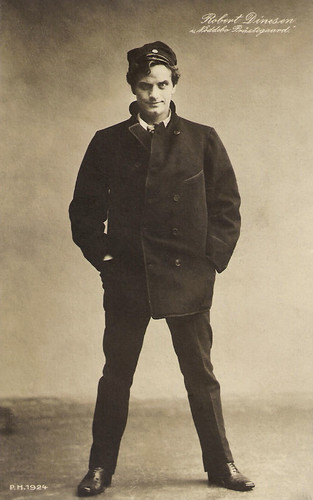
Swedish postcard by P.H. (Paul Heckscher), no. 1924. Sent by mail in 1908. Photo: publicity still for the play 'Nödebbo Prestigaard'. Paul Heckscher was a Swedish publisher of art reproductions, artist-signed cards, coloured and black-and-white views, etc., between 1900 and 1917.

Swedish postcard by P.H. (Paul Hekscher), no. 1929. Photo: Robert Dinesen in the play 'Ambrosius' by Christian Molbech. At the Dagmarteatret he first performed in this play in 1900 and again in 1905 and afterwards toured in 1907 with it to Norway and to Finland.

Finnish postcard. Photo: Robert Dinesen, after the success in Helsinki of his play 'Ambrosius' by Christian Molbech. The text on the card reads "Robert Dinesen, Helsingfors" (Helsinki). The costume is identical to that in 'Ambrosius', in which Dinesen had the lead. At the Dagmarteatret, he first performed in this play in 1900 and again in 1905 and afterwards toured in 1907 with it to Norway and as shown here, to Finland.

Spanish postcard in the Artista de la Casa Nordisk series. Photo: Nordisk. Dinesen's name is misspelt on the card.

German postcard by Photochemie, Berlin, no. 1976. Photo: Nordisk. Gunnar Tolnaes and Lilly Jacobsson in Maharadjahens Yndlingshustru/The Maharaja’s Favourite Wife (Robert Dinesen, Svend Gade, 1917).
Sensational Circus Drama
Robert Dinesen was born in Copenhagen, Denmark in 1874. After being trained as a singer by William Herold and as an actor by Nicolai Neiiendam, he made his stage debut in 1894. He toured in the Nordic countries and played on several of the capital city stages, including the Dagmarteatret (Dagmar Theatre). Until 1913, he played at several theatres in the Nordic countries. At the Dagmarteatret, he performed from 1894 to 1905. Then he worked at Det ny Teater in 1908/09, again at Dagmarteatret in 1909-1910, at Casino in 1911-1912, and again at Det ny Teater in 1912-13. At Det Ny Theater, Dinesen played around 1908 opposite other future film actors such as Svend Aggerholm, Poul Reumert, Asta Nielsen, and Ellen Aggerholm. With Svend and Ellen Aggerholm he acted in 'Den skønne Marseillanerinde' (1908).
In 1910, he started his film career with the spectacular and ground-breaking Afgrunden/The Abyss (Urban Gad, 1910), as Magda's (Asta Nielsen) fiancé. It was also the film debut for Asta Nielsen and Poul Reumert and was the international breakthrough for Nielsen. Already one year later, he co-directed his first film, the circus drama De fire djaevle/The Four Devils (Alexander Christian, Robert Dinesen, Alfred Lind, Carl Rosenbaum, 1911), in which he also played the lead as the wayward circus performer Fritz, opposite Edith Buemann and Agis Winding. The film, based on a story by Herman Bang, was an international success. It launched a trend of sensational circus dramas in Denmark, Germany, and Italy. In 1928, Bang's story would be filmed again in Hollywood by legendary director F.W. Murnau as The Four Devils.
Kinografen, the production company of De fire djaevle/The Four Devils built a large studio to expand, but to no avail. Dinesen moved over to Nordisk, the biggest Danish film studio then. From 1912 on, Robert Dinesen alternated playing in various Nordisk films by directors such as August Blom and Eduard Schnedler-Sorensen with making his own films, also at Nordisk. In 1913 he assisted Blom in directing his prestigious film drama Atlantis (August Blom, 1913). All in all, he acted in and directed some 70 films at Nordisk, working with such actors as Valdemar Psilander, Betty Nansen, and Gunnar Tolnaes.
His biggest success was the orientalist melodrama Maharadjahens yndlingshustru/The Maharaja's Favourite Wife (Robert Dinesen, Svend Gade, 1917) with Gunnar Tolnaes as an Indian prince and Lilly Jacobson as his love interest, the Danish Elly von Langen. The film was so popular that it had a Danish companion piece in 1919, again with Tolnaes and Jacobson, and a German sequel in 1921.
Robert Dinesen also produced such films as Scenen og livet/Stage and Life (1913) with Psilander and Clara Wieth, Dramaet i den gamle Mølle/The Draam in the Old Mill (1913) with Ellen Aggerholm, Et kaerlighedsoffer/I will repay (1914) with Ebba Thomsen, the parts 3, 4 and 5 of the sensationalist series Gar el Hama (1914-1916) starring Aage Hertel, Dr. X (1915) with Tolnaes and Carlo Wieth, and Jefthas Dotter/Jephta's Daughter (1919), a Swedish production by Palladium.

Spanish minicard, no. 2. Photo: Nordisk. Ebba Thomsen and Thorkild Roose in Et kaerlighedsoffer/I will repay (Robert Dinesen, 1914), released in Spain as El infierno del amor.
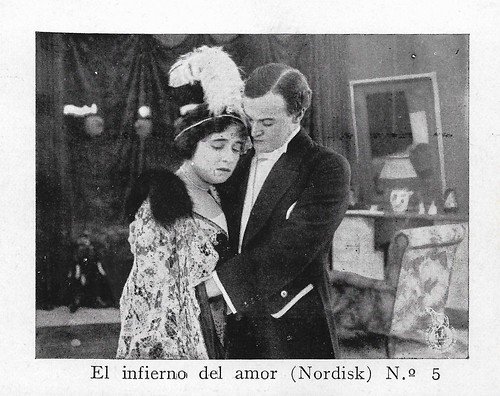
Spanish minicard, no. 5. Photo: Nordisk. Ebba Thomsen and Nicolai Johannsen in Et kaerlighedsoffer/I will repay (Robert Dinesen, 1914), released in Spain as El infierno del amor.

Spanish postcard by Edics. y Publics de Arte L. Planas, Barcelona. no 2. Photo: Nordisk. Gunnar Tolnaes and Carlo Wieth in Doktor X/Doktor Voluntas (Robert Dinesen, 1915).

Spanish postcard by Edics. y Publics de Arte L. Planas, Barcelona. no 4. Photo: Nordisk. Gunnar Tolnaes, Carlo Wieth and probably Johanne Fritz-Petersen in Doktor X/Doktor Voluntas (Robert Dinesen, 1915).

German postcard by Photochemie, no. K. 1917. Photo: Nordisk. Gunnar Tolnaes in Maharadjahens Yndlingshustru/The Maharaja's Favourite Wife (Robert Dinesen, Svend Gade, 1917).
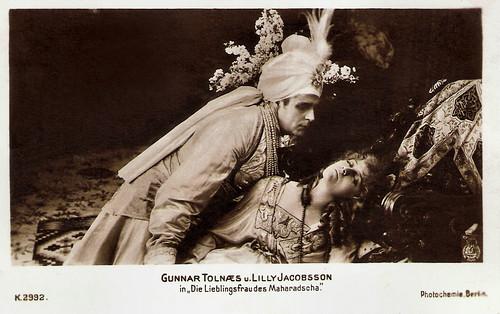
German postcard by Photochemie, Berlin, no. K. 2992. Photo: Nordisk. Gunnar Tolnaes and Lilly Jacobson in Maharadjahens yndlingshustru/The Maharaja's Favourite Wife (Robert Dinesen, 1917).
Lya de Putti
Robert Dinesen married German actress Margaretha Schön, his third wife, and he moved to Berlin. Schön became well-known as Kriemhild in Fritz Lang's epic Die Nibelungen (1924).
Producer Joe May invited him to co-direct with him Die Frauen von Gnadestein/The Women of Gnadestein (1920). In the 1920s, while working for May-Film, Ufa, and Phoebus, Dinesen directed some 25 films. Several of his films starred Lya de Putti. These productions included Ilona (1921), Thamar, das Kind der Berge/Thamar, the Child of the Mountains (1924), Malva (1924), Claire (1924), and Im Namen des Kaisers/In the Name of the Kaiser (1925). Most of them were made shortly before her international breakthrough with Varieté/Variety (E.A. Dupont, 1925).
In 1922 Dinesen made one more film for the Swedish company Palladium, Odets reskap. His last film was Der Weg durch die Nacht/The Way Through the Night (1929) starring Käthe von Nagy, and his wife Margarethe Schön.
Dinesen refused to work for Joseph Goebbels, neither as an actor nor director and retired. He was almost 60 and dedicated his time to painting. His wife Margarethe continued acting after 1933 and did some 24 films until 1945. From 1948 on, she played in 10 more films, of which several at DEFA.
Robert Dinesen remained in Berlin (later West Berlin), and passed away there in 1972 at the age of 97. He had been married to the actresses Marie Dinesen, Johanne Dinesen, née Laura Johanne Winter, and Margarethe Schön. Schön would survive him until 1985 and was then buried with Dinesen at the cemetery Heerstrasse in Berlin. With his first wife Marie, Dinesen was the father of the writer Kirsten Thomsen (1900).

Danish postcard by Alex. Vincent's Kunstforlag. Eneret, no. 709. This card refers to the stage play 'Inez fra Coimbra' by Karl Larsen, in which Ellen Aggerholm played the title role, opposite Dinesen. Aggerholm debuted in this play at Det Ny Teater in 1908, then opposite Poul Reumert and Asta Nielsen.
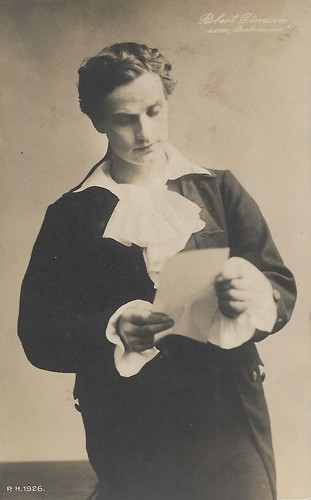
Swedish postcard by P.H. (Paul Hekscher), no. 1926. Photo: Robert Dinesen in the play 'Ambrosius' by Christian Molbech.
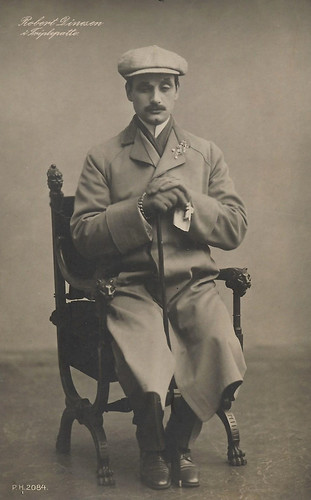
Swedish postcard by P.H. (Paul Hekscher), no. 2084. Photo: Robert Dinesen in the play 'Triplepatte' by Tristan Bernard, which he performed in Helsinki, Finland, in 1908.

German postcard by Photochemie, Berlin, no. K. 1939. Photo: Nordisk Films. Valdemar Psilander in Das Geheimnis des Sphinx, German release title for the Danish silent film Sfinxens Hemmelighed/The Secret of the Sphinx (Robert Dinesen, 1918).

Austrian postcard by Projectograph Aktiengesellschaft, Wien (Vienna). Photo: Nordisk Films Co., Kopenhagen.

German postcard by Verlag Hermann Leiser, no. 58.
Sources: Hans J. Wollstein (AllMovie), Mona Dubgaard (Saersamlinger - Danish), Det Danske Filminstitut (Danish) and IMDb.
This post was last updated on 10 January 2024.
1 comment:
I don't know if I missed it but is Robert Dinesen any relation to Isak Dinesen, the author of "Out of Africa?" :)
Post a Comment